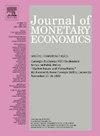Decomposing the monetary policy multiplier
IF 4.3
2区 经济学
Q1 BUSINESS, FINANCE
引用次数: 0
Abstract
Financial markets play an important role in generating monetary policy transmission asymmetries in the U.S. Credit spreads only adjust to unexpected increases in interest rates, causing output and prices to respond more to a monetary contraction than to a monetary loosening. At a one year horizon, the ‘financial multiplier’ of monetary policy — defined as the ratio between the cumulative responses of employment and credit spreads — is zero for a monetary loosening, -2 for a monetary contraction, and -4 for a monetary contraction that takes place under strained credit market conditions. These results have important policy implications: monetary policy may become inadvertently tight in times of financial distress.
分解货币政策乘数
在美国,金融市场在造成货币政策传导不对称方面发挥着重要作用。信贷息差只会对利率的意外上升做出调整,导致产出和价格更多地对货币紧缩做出反应,而不是对货币宽松做出反应。在一年的期限内,货币政策的“金融乘数”——定义为就业和信贷息差的累积反应之间的比率——在货币宽松时为零,在货币紧缩时为-2,在信贷市场紧张条件下发生的货币紧缩时为-4。这些结果具有重要的政策含义:在金融危机时期,货币政策可能会在不经意间变得紧缩。
本文章由计算机程序翻译,如有差异,请以英文原文为准。
求助全文
约1分钟内获得全文
求助全文
来源期刊

Journal of Monetary Economics
Multiple-
CiteScore
7.20
自引率
4.90%
发文量
90
审稿时长
74 days
期刊介绍:
The profession has witnessed over the past twenty years a remarkable expansion of research activities bearing on problems in the broader field of monetary economics. The strong interest in monetary analysis has been increasingly matched in recent years by the growing attention to the working and structure of financial institutions. The role of various institutional arrangements, the consequences of specific changes in banking structure and the welfare aspects of structural policies have attracted an increasing interest in the profession. There has also been a growing attention to the operation of credit markets and to various aspects in the behavior of rates of return on assets. The Journal of Monetary Economics provides a specialized forum for the publication of this research.
 求助内容:
求助内容: 应助结果提醒方式:
应助结果提醒方式:


